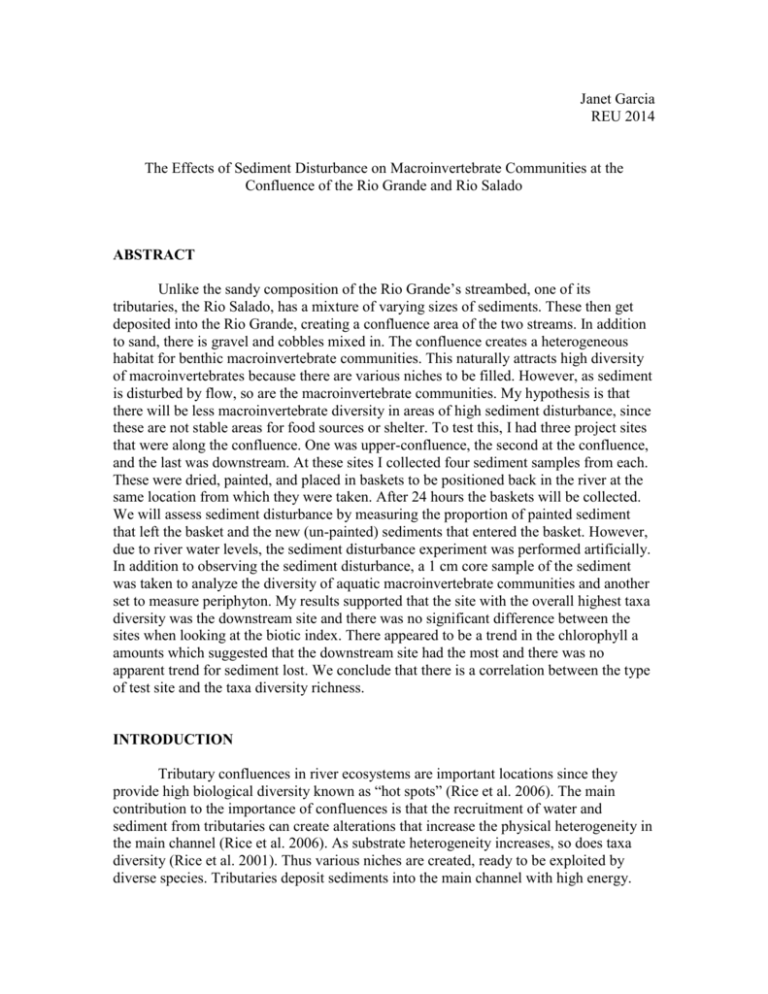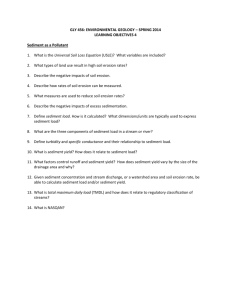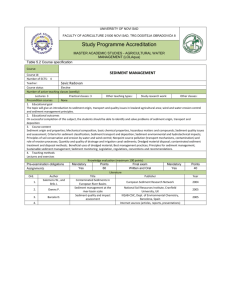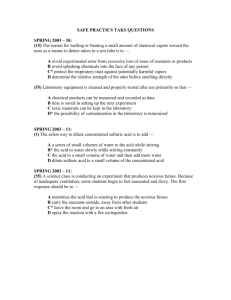j.garcia_report
advertisement

Janet Garcia REU 2014 The Effects of Sediment Disturbance on Macroinvertebrate Communities at the Confluence of the Rio Grande and Rio Salado ABSTRACT Unlike the sandy composition of the Rio Grande’s streambed, one of its tributaries, the Rio Salado, has a mixture of varying sizes of sediments. These then get deposited into the Rio Grande, creating a confluence area of the two streams. In addition to sand, there is gravel and cobbles mixed in. The confluence creates a heterogeneous habitat for benthic macroinvertebrate communities. This naturally attracts high diversity of macroinvertebrates because there are various niches to be filled. However, as sediment is disturbed by flow, so are the macroinvertebrate communities. My hypothesis is that there will be less macroinvertebrate diversity in areas of high sediment disturbance, since these are not stable areas for food sources or shelter. To test this, I had three project sites that were along the confluence. One was upper-confluence, the second at the confluence, and the last was downstream. At these sites I collected four sediment samples from each. These were dried, painted, and placed in baskets to be positioned back in the river at the same location from which they were taken. After 24 hours the baskets will be collected. We will assess sediment disturbance by measuring the proportion of painted sediment that left the basket and the new (un-painted) sediments that entered the basket. However, due to river water levels, the sediment disturbance experiment was performed artificially. In addition to observing the sediment disturbance, a 1 cm core sample of the sediment was taken to analyze the diversity of aquatic macroinvertebrate communities and another set to measure periphyton. My results supported that the site with the overall highest taxa diversity was the downstream site and there was no significant difference between the sites when looking at the biotic index. There appeared to be a trend in the chlorophyll a amounts which suggested that the downstream site had the most and there was no apparent trend for sediment lost. We conclude that there is a correlation between the type of test site and the taxa diversity richness. INTRODUCTION Tributary confluences in river ecosystems are important locations since they provide high biological diversity known as “hot spots” (Rice et al. 2006). The main contribution to the importance of confluences is that the recruitment of water and sediment from tributaries can create alterations that increase the physical heterogeneity in the main channel (Rice et al. 2006). As substrate heterogeneity increases, so does taxa diversity (Rice et al. 2001). Thus various niches are created, ready to be exploited by diverse species. Tributaries deposit sediments into the main channel with high energy. The types of sediments that are deposited are usually large like rocks, cobbles, and stones. Depending on particle surface roughness, this will affect periphyton growth and detritus retention, which in turn influences food availability for insects and higher trophic levels (Rice et al. 2001). Also, high water discharge can cause coarse sediment disturbance and agitate periphyton and invertebrate communities (Schwendel et al. 2011). Periphyton is a mixture of algae, cyanobacteria, microbes and detritus, which is usually found on underwater surfaces. In general there are two types of macroinvertebrates regarding movement or lack thereof, sessile and motile. Sediment disturbance creates a zonation pattern where sessile organisms are excluded from dynamic sediments and motile organisms are favored (Hinchey et al. 2006). These organisms are affected when they experience sediment disturbance directly and when the nearby periphyton is also disturbed. The Rio Grande and Rio Salado confluence provides us with a tributary-main stream system. Different from the Rio Grande, the Rio Salado has a heterogeneous mix of sediments. Not only does it have sand but it also has gravel, rocks, cobbles, and stones. The goal of this study is to explore how the heterogeneous habitat of the confluence affects benthic macroinvertebrate communities. Macroinvertebrates live in water for all or most of their life, making them great bioindicators of lotic ecosystem health. These critters also provide lotic ecosystems with nutrient cycling of important ecological materials as well as add to the overall river biodiversity (Mac Nally et al. 2011). They are an intermediate link between primary producers, primary consumers and higher predators (Malmqvist 2002). MATERIALS AND METHODS My project location is along the confluence of the Rio Salado and Rio Grande within the boundaries of the Sevilleta National Wildlife Refuge which is situated at approximately 34°16'21.27"N 106°51'29.44"W. Within this research area, there are three testing locations: upper edge of the confluence, middle of the confluence, and downstream. At each of the testing locations, three different samples were taken. There was a sediment, macroinvertebrate, and periphyton sample taken. To first determine where we would take sediment samples from, velocity measurements were taken to find areas of similar velocity and thus similar sediment disturbance would also be seen here. Four replicate sediment samples were taken from each of the three sites about 5m apart to total 12 sediment samples. Next, we took macroinvertebrate samples from each of the 12 sediment sites. Four 1cm sediment cores were taken from each site using a 60ml syringe. Right after collection, ethanol was poured on the samples to preserve them. These samples were then taken to the laboratory where they were placed on a 250m sieve and sifted through with water to find and pull out the macroinvertebrates. Once all the macroinvertebrates were separated from the sediment, they were sorted and identified and placed in site-specific vials. Lastly, periphyton samples were also taken from the same 12 sites as the macroinvertebrates. Three 2ml cores were taken from the sites using the same syringe. Samples were placed in 50ml centrifuge tubes and these were wrapped in aluminum foil right after collection as a means of stopping photosynthesis. The periphyton samples were placed in the freezer to preserve them and later taken to the University of New Mexico. There, ethanol was poured into the tube samples to extract the chlorophyll and were ran through a spectrophotometer to get a reading on chlorophyll a amounts. The sediment samples were taken to the laboratory where various procedures followed. They were dried under the hot New Mexican sun, weighed, and placed through a sieve column that shook for three minutes. The sieve column separated the sediment sample into grain sizes. The various grain sizes were weighed to get proportions of the sediment composition. After, each sample was spray-painted bright orange to provide a strong contrast with the natural river sediments. Originally, the sediment disturbance experiment was to be executed by placing the painted sediments in baskets back into the river from the same location where they were collected from. This was to be done to assess sediment movement. After 24 hours we wanted to see what proportion of the painted sediment had flowed out of the basket. However, towards the end of the month of June 2014 pre-monsoon rains came and elevated the height of the river. This made it too deep and thus unsafe to enter and place the baskets. In spite of this, the experiment was conducted artificially at the Sevilleta Long Term Ecological Research Field Station. Here I nestled the painted sediment baskets in a rectangular container that contained a sand matrix. A garden hose was attached to the larger container and was used to fill it up and act as our “river.” The hose knob was marked off in three areas as a way to standardize three velocities ranging from low to high as a means to mimic what we had found in the river. The low velocity was used for all upper-confluence samples, medium velocity for confluence samples, and high velocity for downstream samples. Before the water was turned on, a before picture was taken of the painted sediment. Each sample was placed in the matrix one by one and the water hose ran for 30 minutes at the respective site velocity. After the trial was done, a picture was taken again of the sample to measure proportion of the sediment that left the sample. ImageJ, a computer program was used to do a qualitative image analysis on the photos to measure sediment disturbance. This was later presented as the percentage of sediment lost at each of the sites. RESULTS Macroinvertebrates The overall abundance of macroinvertebrates at each of the research sites seems to indicate that there is a trend. It appears that abundance is increasing on a positive slope from the upper-confluence site to the downstream site (Fig. 1). However, once an ANOVA test was run on this data, it showed that there was no significant difference between the sites affecting the macroinvertebrate abundance. Taxa diversity was assessed using Shannon-Weiner’s diversity index which accounts for species richness and evenness. Again, there appeared to be a trend alluding that the downstream had the most diversity (Fig. 2). An ANOVA test was run on this data, which gave us a p-value of 0.021, which is less than 0.5 meaning that there was a significant difference. We are 95% sure that the downstream site in fact is more diverse than the other two sites. In total, eight different taxa were found and they were classified into six families, one phylum, and one subclass. Families: Chironomidae, Leptohyphidae, Ceratopogonidae, Simuliidae, Hydropsychidae, Baetidae; Phylum: Nematomorpha; Subclass: Oligochaeta. The sites were predominantly the most abundant with members of the family Chironomidae and the least with Baetidae (Fig. 3). The biotic index is a scale that measures the quality of a habitat based on the types of organisms that live in it. The most tolerable are given a score of 10 and the most sensitive are given a score of 0. When evaluating the biotic score of the sites, we found that there was no significant difference between the sites and the biotic score their organisms were given (Fig. 4). Periphyton To measure periphyton, we looked at the quantity of chlorophyll a in each of the samples. After the periphyton samples were run through the spectrophotometer, the results were just as I had expected. Although no statistical tests were run on this data, we see a clear trend (Fig. 5). It appears that the downstream site has the highest amount of chlorophyll a with 23.3 mg/m2 and the upper-confluence site only had 8.7 mg/m2. Sediment disturbance There appears to be no actual trend between the sites. The upper-confluence site had a mean 32.5% of sediment lost and the confluence had 31.8% (Fig. 6). This closeness in percentages leads us to conclude that there might have been various factors affecting the data collection while the experiment was running and the experiment design. It was expected to observe that the upper site would have the most disturbance and the downstream site to have the least. DISCUSSION Macroinvertebrates We first see that there is no significant difference between the research sites when assessing overall macroinvertebrate abundance. This suggests that the location where they are found along the confluence does not have an affect on their amount. However their quantities could be due to other factors such as sediment coarseness, periphyton availability, and sediment disturbance. The taxa diversity among the sites was significantly greater at the downstream locations. Downstream of the confluence is where a “…combination of coarse sediment inputs (gravel and cobble size)…” is found (Svendsen et al. 2009). Luttenton and Baisden (2006) mention that their findings on greater taxa diversity being on larger substrata is consistent with that of Patrick’s (1967, 1976) results on his studies. It makes sense that more diversity can be supported on larger sediments because they don’t experience as much disturbance as sand would and therefore provide a stable habitat. The upper-confluence site is predominantly made up of sand and thus only the most tolerable organisms can survive there. In this case, it was the chironomids. Luttenton and Baisden (2006) state that sediment abrasion [Horner et al. 1990] is a common mechanism by which periphyton communities are disturbed. This means that sand acts as “sand paper” when it is disturbed by water flow and periphyton gets scraped off resulting in no stable food sources. Periphyton The trend suggests that the downstream test location was the one with the most chlorophyll a amounts. This came as no surprise since we just discussed how in the downstream area there are larger/heavier sediment particles and therefore don’t tumble with water flow, preventing most periphyton from being scraped off. Death (1996) mentions in his study that periphyton biomass increased with decreasing disturbance frequency. This supports my results and also tells us that disturbance decreases from the upper-confluence site to the downstream site. Sediment disturbance This experiment gave us an unclear trend. We can’t really extract any logistic data from the graph; however, there are possible factors to having an unclear trend. This experiment design had never been done before, so naturally there were various mishaps. Although the hose was positioned in such a way to evenly water the catching container, holes were still created in the sand matrix, potentially disrupting sediment movement and water flow. Also, the ImageJ software that was used to qualitatively assess the photos for sediment lost could have been a factor. In this program, the individual uses their best judgment on recreating the contrast of the photo on the software, leaving a lot of room for error. However, what I would’ve expected to see was that the sandy upper-confluence site to have the most disturbance and the downstream site to have the least since it has mainly large and heavy sediments. In the future, it would be interesting to gather these same samples again, however, post-monsoon season to compare them to this pre-monsoon data. With rainfall, comes more water to fill and overflow rivers and these in turn have a higher water discharge. With higher energy in the rivers, this can move more sediment and especially those that are larger and heavier. We would expect to observe disturbance to the downstream areas that were not seen during the pre-monsoon season. Following monsoon season, we could also look at how the macroinvertebrate community recovers after a greater disturbance. There are various mechanisms that allow these biota to survive or recover from natural disturbances (Palmer 1992). Literature Cited Death, R. "The Effect of Patch Disturbance on Stream Invertebrate Community Structure: The Influence of Disturbance History." Oecologia, 108.3 (1996): 567-576. Hinchey, Elizabeth, Linda Schaffner, Cara Hoar, Bruce Vogt, and Lauren Batte. "Responses of Estuarine Benthic Invertebrates to Sediment Burial: The Importance of Mobility and Adaptation." Hydrobiologia, 556.1 (2006): 85-98. Luttenton, Mark, and Cathy Baisden. "The Relationships Among Disturbance, Substratum Size and Periphyton Community Structure." Hydrobiologia, 561.1 (2006): 111-117. Mac Nally, Ralph, Elizabeth Wallis, and P Lake. "Geometry of Biodiversity Patterning: Assemblages of Benthic Macroinvertebrates at Tributary Confluences." Aquatic Ecology, 45.1 (2011): 43-54. Malmqvist, Bjorn. "Aquatic Invertebrates in Riverine Landscapes." Freshwater Biology, 47.4 (2002): 679. Palmer, M. A. "Response of Invertebrates to Lotic Disturbance: A Test of the Hyporheic Refuge Hypothesis." Oecologia, 89.2 (1992): 182-194. Rice, S. P., M. T. Greenwood, and C. B. Joyce (2001). “Macroinvertebrate community changes at coarse sediment recruitment points along two gravel bed rivers.” Water Resour. Res., 37(11), 2793–2803. Rice, Stephen P, Robert I Ferguson, and Trevor B Hoey. "Tributary Control of Physical Heterogeneity and Biological Diversity at River Confluences." Canadian Journal of Fisheries and Aquatic Sciences, 63.11 (2006): 2553. Schwendel, Arved, Russel Death, Ian Fuller, and Mike Joy. "Linking Disturbance and Stream Invertebrate Communities: How Best to Measure Bed Stability." Journal of the North American Benthological Society, 30.1 (2011): 11-24. Svendsen, K. M., Renshaw, C. E., Magilligan, F. J., Nislow, K. H. and Kaste, J. M. (2009). “Flow and sediment regimes at tributary junctions on a regulated river: impact on sediment residence time and benthic macroinvertebrate communities.” Hydrol. Process., 23: 284–296. Appendix Fig. 1 Macroinvertebrate abundance by site Fig. 2 Macroinvertebrate diversity by site Fig. 3 Taxa distribution among the sites Fig. 4 Biotic index of the macroinvertebrates by site Fig. 5 Chlorophyll a amounts at each of the sites Fig. 6 Percent of sediment lost at each site









